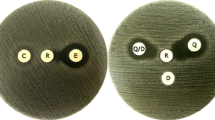Summary
Sulbactam/ampicillin (Unasyn™) possesses the antimicrobial activity of each drug plus the synergistic action and qualities of sulbactam used as a β- lactamase inhibitor. The combination has a spectrum of activity against many Enterobacteriaceae, Haemophilus species, Branhamella catarrhalis, pathogenic Neisseria species, Acinetobacter anitratus, some pseudomonads, nearly all anaerobes (including Bacteroides), Staphylococcus species, streptococci, and the enterococci. Sulbactam/ampicillin was found to be bactericidal, and its minimum inhibitory concentrations (MICs) affected only by high inoculum concentrations (> 106 CFU/ml).
Fixed ratio in vitro susceptibility tests appear to be preferred, since they best approximate clinical formulations and drug pharmacokinetics. The ratio of 1:1 has been studied, but other ratios such as 1:2 (sulbactam/ampicillin) should be evaluated to promote greater test accuracy. Separate interpretive criteria for most Gram- negative bacteria, Haemophilus, and staphylococci appear unnecessary for some tests.
Similar content being viewed by others
References
Appelbaum PC, Jacobs MR, Spangler SK, Yamabe S. Comparative activity of β-lactamase inhibitors YTR 830. clavulanate, and sulbactam combined with β-lactams against β-lactamase- producing anaerobes. Antimicrobial Agents and Chemotherapy 30: 789–791, 1986
Aronoff SC. Jacobs MR, Johenning S, Yamabe S. Comparative activities of β-lactamase inhibitors YTR 830, sodium clavulanate and sulbactam combined with amoxicillin and ampicillin. Antimicrobial Agents and Chemotherapy 26: 580–582, 1984
Aswapokee N, Neu HC.A sulfone β-lactam compound which acts as a β-lactamase inhibitor. Journal of Antibiotics 31: 1238–1243. 1978
Barry AL, Jones RN, Thornsberry C. Interpretive standards and quality control limits for susceptibility tests with ampicillin/ sulbactam combination disks. Journal of Clinical Microbiology 19: 134–139, 1984
Barry AL, Jones RN, Packer RR. In vitro susceptibility of the Bacteroides fragilis group to cefoperazone, ampicillin, ticarcillin and amoxycillin combined with β-lactamase inhibitors. Journal of Antimicrobial Chemotherapy 17: 125–127, 1986
Brown RM, Wise R, Andrews JM, Hancox J. Comparative pharmacokinetics and tissue penetration of sulbactam and ampicillin after concurrent intravenous administration. Antimicrobial Agents and Chemotherapy 21: 565–567, 1982
English AR, Retsema JA, Girard AE, Lynch JE, Barth WE. CP-45, 899, a β-lactamase inhibitor that extends the antibacterial spectrum of β-lactams: initial bacteriological characterization. Antimicrobial Agents and Chemotherapy 14: 414–419. 1978
Fuchs PC. Barry AL, Thornsberry C, Gavan TL. Jones RN. In vitro evaluation of Augmentin by broth microdilution and disk diffusion susceptibility testing: regression analysis, tentative interpretive criteria, and quality control limits. Antimicrobial Agents and Chemotherapy 24: 31–38, 1983
Hartley S, Wise R. A three-way crossover study to compare the pharmacokinetics and acceptability of sultamicillin at two dose levels with that of ampicillin. Journal of Antimicrobial Chemotherapy 10: 49–55, 1982
Jacobs MR, Aronoff SC, Johenning S. Shlaes DM, Yamabe S. Comparative activities of the β-lactamase inhibitors YTR 830, clavulanate, and sulbactam combined with ampicillin and broad-spectrum penicillins against defined β-lactamase-producing aerobic gram-negative bacilli. Antimicrobial Agents and Chemotherapy 29: 980–985. 1986
Jones RN, McDougal LK, Thornsberry C. Inhibition and hydrolysis studies of β-lactamases found in Legionella species: antimicrobial activity of new macrolides on Legionellae. In Thornsberry et al. (Eds) Legionella, the proceedings of the Second International Symposium, American Society for Microbiology, Washington, DC, pp. 100–103, 1984
Kager L, Liljeqvist L, Malmborg AS, Nord CE, Pieper R. Effects of ampicillin plus sulbactam on bowel flora in patients undergoing colorectal surgery. Antimicrobial Agents and Chemotherapy 22: 208–212, 1982
National Committee for Clinical Laboratory Standards. Performance standards for antimicrobic disk susceptibility tests, 3rd ed. Approved Standard: M2–A3. NCCLS, Villanova. PA, 1984
National Committee for Clinical Laboratory Standards. Standard methods for dilution antimicrobial susceptibility tests for bacteria which grow aerobically. Approved Standard: M7-A. NCCLS, Villanova, PA, 1985
Neu HC. Contribution of β-lactamases to bacterial resistance and mechanisms to inhibit β-lactamases. American Journal of Medicine 79 (Suppl. 5B): 2–12, 1985
Retsema JA, English AR, Girard AE. CP-45,899 in combination with penicillin or ampicillin against penicillin-resistant Staphylococcus. Haemophilus, influenzae and Bacleroides. Antimicrobial Agents and Chemotherapy 17: 615–622, 1980
Roy C, Foz A, Segura C. Plasmid-mediated β-lactamases identified in a group of 204 ampicillin-resistant Enterobacteriaceae. Journal of Antimicrobial Chemotherapy 12: 507–510, 1980
Simpson IN, Harper PB, O’Callaghan CH. Principal β-lactamases responsible for resistance to β-lactam antibiotics in urinary tract infections. Antimicrobial Agents and Chemotherapy 17: 929–936, 1980
Wise R, Andrews JM, Bedford KA. Clavulanic acid and CP-45,899: a comparison of their in vitro activity in combination with penicillins. Journal of Antimicrobial Chemotherapy 6: 197–206, 1980
Author information
Authors and Affiliations
Rights and permissions
About this article
Cite this article
Jones, R.N. In Vitro Evaluations of Aminopenicillin/β-Lactamase Inhibitor Combinations. Drugs 35 (Suppl 7), 17–26 (1988). https://doi.org/10.2165/00003495-198800357-00005
Published:
Issue Date:
DOI: https://doi.org/10.2165/00003495-198800357-00005




